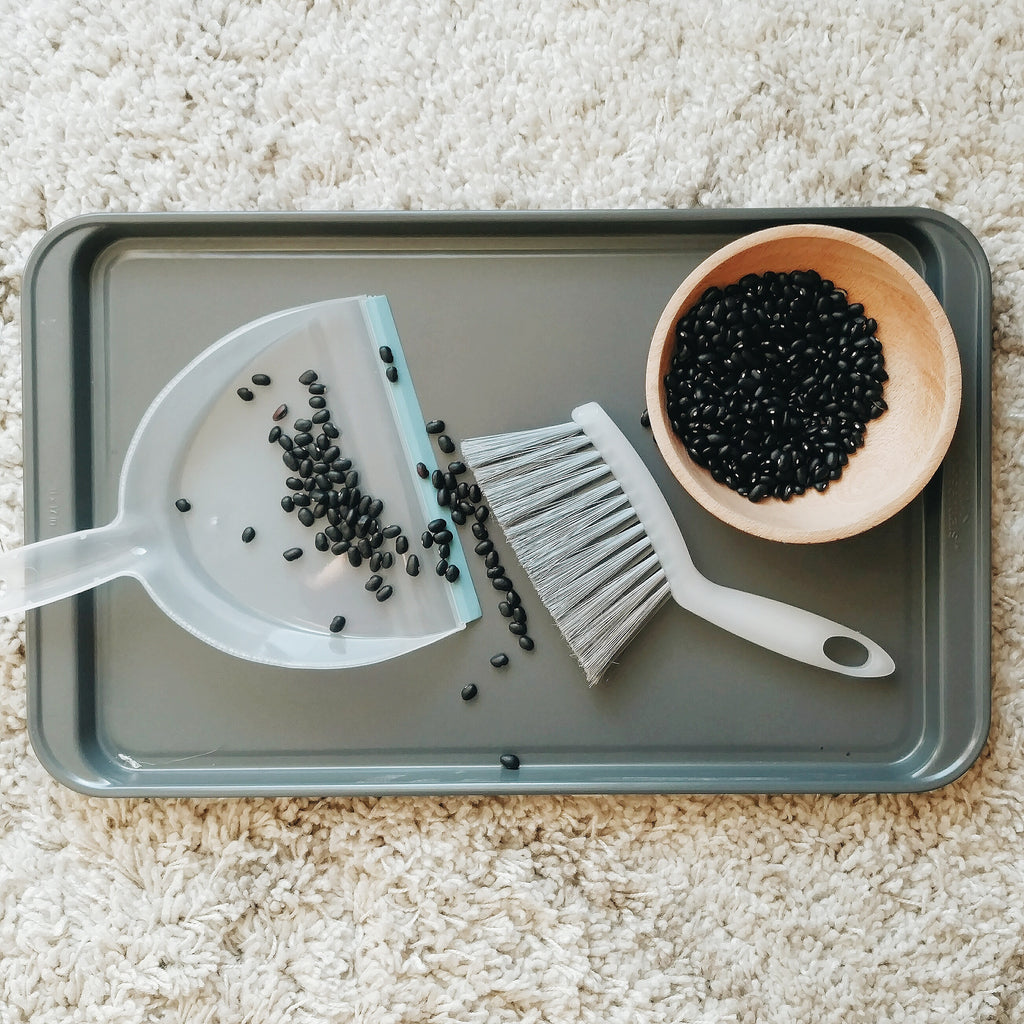I adore Tot Trays. If you have never set them up for your children, they may seem like a lot of work from the outside. They could be, but they can also be incredibly simple. You can usually find a mix of super low-prep and moderate-prep trays on my shelf at any given time. Here are the two main reasons I love having Tot Trays as part of our schooling.
In this blog post:
- Benefits of Tot Trays for preschool learning
- Tot Tray setup examples
- More preschool resources from Treehouse Schoolhouse
Benefits of Tot Trays for preschool learning
Tot Trays encourage independent learning
I typically introduce each tray to my children by sitting with them to complete it until I can tell that they understand. Typically after one or two demonstrations, I don’t use the trays in a scheduled teaching time. From them on, they are available at my children’s level to take off the shelf and interact with on their own. Sometimes they ask me to to work with them and other times my two preschoolers work together with each other. I do not push them to explore any one tray. However, our homeschool shelf which holds all of our trays is in the living room where we spend most of our day. Throughout the day I frequently see them each go over to the shelf and pull something off to explore.
Tot Trays require one-time prep for lots of repeating learning experiences
Have you ever spent forever preparing a preschool activity to have your child reluctantly half-complete it and then toss it to the side? A few experiences like that is enough to make you want to stop home educating all together. I love Tot Trays because what my child might have zero interest in on Monday, they may love by Friday. Usually, I rotate our trays out every weekend, but some stick around longer if they are getting a lot of use.
There are endless amounts of ideas online for setting up tot trays. I use light-weight trays, baskets, and small bowls. Sometimes, even a cookie sheet. Whatever you have that your child can pick up and carry. We have an open shelf in our living room that my husband built specifically for this purpose, but any shelf at your child’s level will do. When preparing to set mine up I look for a few key things. I want them to be realistic in prep time, not require constant supervision (not messy or dangerous), and the activity should reach the perfect balance of my child’s abilities and a challenge. My shelf usually has at least one sensory tray such as beans with small bowls and Helping Hands tools. I also always have a tray with our current letter’s 3-part cards, which I offer as a free printable. The rest of the trays are usually activities to practice counting, matching, and fine motor skills. Sometimes they correlate with a book we are reading or a theme we are studying.
Tot Tray setup examples

Supplies used: Cookie tray | Mini broom & dustpan | Little bowls | Black beans

Supplies used: Tweezers | Pom-poms | Trays | Construction paper

Supplies used: Basket | Preschool scissors | Construction paper

Supplies used: Tray | Small bowls | Sticks | Toilet paper roll | About Birds

Supplies used: Tray | Construction paper | Single hole punch

Supplies used: Basket | Small bowls | Illustrated 3-part cards | Real Life 3-part cards
My favorite Tot Tray Supplies not pictured:
More preschool resources from Treehouse Schoolhouse
Are you looking for more learning resources or learning material for toddlers or preschoolers in your home? Consider these best-selling products from Treehouse Schoolhouse that offer a gentle invitation to learning for small children.
Treehouse Story School: Preschool

Treehouse Story School: Preschool is 32-weeks of gentle, literature-based curriculum designed for ages 2.5-5 years. This preschool curriculum that invites children to learn through the themes in stories they love. Each week will focus on a picture book, inviting children into connection and learning through music and movement, play-based narration, alphabet and number play, motor skills, practical life development, crafts, and baking together.
It would be a great fit for your toddler or preschooler if you are looking to incorporate multi-sensory, play-based learning while introducing them to timeless stories.
From toddler through upper preschool, this curriculum can be used year after year as you dive deeper into beloved, classic stories your family will cherish. Preview a free week here.
Daily Rhythm Bundle

Children are highly visual–they can feel particularly out of control when they don’t know what to expect of their day. That’s why we recommend using a visual schedule to support your children from the time they are very young.
Rather than trying to stick to a rigid schedule, this set helps you create a general rhythm for your days. The daily rhythm worksheet is laminated and dry erase and the cards can be moved around offering you flexibility and adaptability.
Morning Time Bundle

This interactive, reusable set focuses on weather, seasons, moon phase, temperature, weather-appropriate clothing, date and time, and reading a calendar. With this daily bundle, your child will practice the skills of handwriting, tracing, copywork, and telling time. I recommend you print these materials and place them inside of a Morning Time Menu or dry-erase sleeve. Using dry-erase markers, your child can fill this bundle out over and over again.
We also offer a version of the Morning Time Bundle for those in our community who live in the Southern Hemisphere.
Will you try using Tot Trays in your homeschool preschool? Let us know in the comments below.

![Top Beginner Books for Kids [Free Beginner Readers Booklist]](https://storage.googleapis.com/treehouse-schoolhouse-media-dev/0da4584e-img_5406.jpg)

